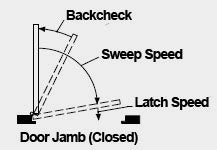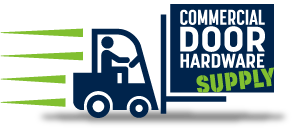+Shop
Door Closer Information
Door Closer Mounting Types

Here are some of the positives and negatives of each mounting type to help you decide which is best for your application.
Regular Arm
This is the only pull-side application where a double lever arm is used. It is the most power efficient application for a door closer.
Since the arm assembly projects directly out from the door frame, the Regular Arm mounting may present aesthetic issues.
Top Jamb:
For efficiency reasons this application provides the best alternative to the Regular Arm mounting. Top Jamb mounting provides the best door control for doors in exterior walls that swing out of the building.
The entire door closer and arm assemble project from the frame, similar to the Regular Arm mounting.
Parallel Arm:
This application provides the most appealing appearance for an overhead surface mounted door closer having a double lever arm. It is also beneficial in abuse (vandalism) prone areas. It is on the push side of the door and the arm assembly extends almost parallel to the door. When the door is closed there is very little hardware projecting from the frame face.
Parallel Arm application will also allow the door to swing 180 degrees.
Due to the geometry of the arm, it is approximately 25% less power efficient than Regular Arm or Top Jamb mounting.
Door Closers Control Door Operation

Backcheck
Backcheck slows the door in the opening swing to help keep it from hitting an adjacent wall or having wind throw it out of your control. Backcheck resistance should only be felt near the fully open position.
Backcheck is not a door stop
Most of our Grade 1 door closers offer fully adjustable Backcheck.
Sweep Speed Control
Sweep speed (door closing speed) is the time frame from the start of the door closing to a couple inches before the door hits its latch point. The last few inches of closing are controlled via the latch speed valve if one is included.
Latch Speed
The Latch Zone is the last few inches before the door hits its latch point. This closing zone is controlled via the latch speed valve.Note: A properly adjusted door closer latch speed should never slam the door closed causing stress on the door and frame.
Hold Open or Hold Open Arms
Hold Open is the ability of the door closer to hold the door in the open position. Most door closers achieve this function via a special type of arm (Hold Open Arm).
Replacing an Existing Door Closer
If you need to replace a door closer and don't want to drill more holes in the door, you might be able to find a closer that will bolt up to the existing holes. Contact us for assistance.
Door Closer Power or Spring Size
Door Closers are rated by opening/closing force "Size". The Size ratings are from #1 to #6, with Size #1 the weakest strength and Size #6 the strongest.
- Size #1 = 2 pounds of closing force, minimum
- Size #2 = 3 pounds of closing force, minimum
- Size #3 = 5 pounds of closing force, minimum
- Size #4 = 8 pounds of closing force, minimum
- Size #5 = 11 pounds of closing force, minimum
- Size #6 = 14 pounds of closing force, minimum
Many of our most popular door closers have an adjustable Spring/Power setting.
Example: If a door closer is listed with a Spring Size of 3-6 then it is adjustable through the Power range of #3 (5 pounds of force) to #6 (14 pounds of force).
If the door closer is non-adjustable Spring/Power, meaning it is a Fixed Size, there is no way to adjust the door to open or close lighter/stronger.
*NOTE: The content of this page is presented for informational purposes only and is not meant to serve as complete door closer installation instructions, which are provided by the manufacturer. Commercial Door Hardware Supply is not responsible for installation or performance of hardware it sells, and cannot be held liable for improper installation.
Company Info
Resources
Why Buy From Us?
 Huge Inventory
Huge Inventory
 No Hassle Returns
No Hassle Returns
 Satisfaction
Satisfaction
 Guaranteed
Guaranteed


News & Updates
Sign up to get the latest on sales, new releases and more …


 Huge Inventory
Huge Inventory Guaranteed
Guaranteed